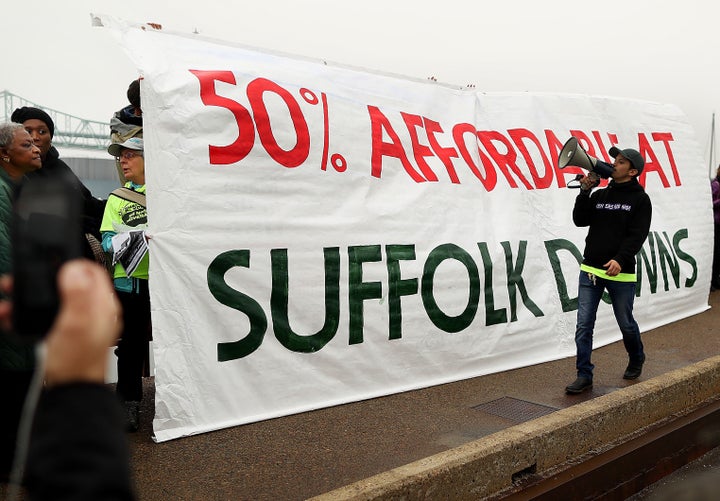On Thursday, Bernie Sanders signaled his opposition to a large-scale property redevelopment in Boston, arguing that it would drive gentrification and displacement.
“We need affordable housing for all instead of more gentrifying luxury developments for the few,” the Vermont senator and 2020 presidential candidate wrote on Twitter. He then expressed solidarity with the community organizers opposing Suffolk Downs, a large-scale housing and retail project on the site of a defunct horse racing track in East Boston.
To most Americans, Sanders’ tweet would have sounded like a benign statement against two things nobody ever argues in favor of: displacement and gentrification. To the activists and policy wonks engaged in a yearslong, increasingly acrimonious debate about how to solve America’s housing crisis, the presidential candidate’s opposition to the development was a declaration of allegiance, the endorsement of a specific worldview about what is broken with America’s housing market and how to fix it.
To understand the debate, we have to start with the Suffolk Downs project itself. The 161-acre site, located in a low-income, mostly immigrant neighborhood roughly a 15 minutes’ drive from central Boston, was sold to a local real estate company in 2017. The developer, HYM Investment Group, intends to transform the site into a complex of new housing, high-end retail and newly landscaped open space.
Two community groups, GreenRoots Inc. and City Life/Vida Urbana, oppose the Suffolk Downs project, citing affordability and climate concerns, as the Boston Business Journal has reported. In December, the groups held a rally to demand that half the development’s units be reserved for poor residents.
Lawyers for Civil Rights, which is representing the neighborhood groups, says that the community’s low-income residents are not represented on the city’s advisory group and that HYM has not released information about improvements to local transit or how it will mitigate the project’s climate impacts. The groups filed a federal complaint last month to delay the project until developers conduct more Spanish-language outreach.
“For our community, largely these processes have been presentations but not dialogues,” City Life/Vida Urbana organizer Andres Del Castillo, told the Boston Globe. “The idea that this has somehow been a representative community process is not true.”

Housing advocates on the other side of the debate argue that the project is a crucial step toward solving Boston’s unprecedented housing crisis. Since 2011, the city’s median rent has climbed from roughly $1,800 per month to $2,950. The Suffolk Downs site is near transit and almost entirely abandoned, meaning the redevelopment would not cause any direct displacement of local residents. The project includes 10,000 new housing units, 1,430 of which will be reserved for Bostonians making less than $75,000 per year. It would also create hundreds of jobs, increase the city’s tax base and construct a 40-acre park.
“Suffolk Downs represents one of the largest constructions of affordable housing the city has ever seen,” said Katherine Einstein, a Boston University professor and the co-author of “Neighborhood Defenders: Participatory Politics and America’s Housing Crisis.” Considering that it costs around $500,000 to build a single unit of housing in Boston, requiring HYM to rent half of the Suffolk Downs apartments at below-market rates would render the project financially infeasible.
“If you want to make the economics of building 1,430 units of affordable housing work,” she said, “the rest of the units have to make a profit.”
Sanders Has Sent Mixed Messages on Housing
The disagreement over the Suffolk Downs project is a microcosm of a larger debate within the progressive movement about the cause of the housing crisis and how to fix it. On one side is the YIMBY (Yes in My Backyard) movement, whose members believe that the affordability crisis can be addressed by allowing more construction of every form of housing — from homeless shelters to gleaming high-rises. Jobs and people are clustering in cities. The way to accommodate them, as a recent New York Times op-ed put it, is to “Build Build Build Build Build Build Build Build Build Build Build Build Build Build.”

On the other side of the debate are tenants’ rights advocates and neighborhood groups who believe that cities should address the housing crisis by prioritizing affordability. Until the populations most at risk of displacement — especially low-income tenants in gentrifying neighborhoods — are protected through rent control, eviction protections and an expansion in public housing, cities should not permit more apartment complexes for the wealthy.
By declaring his opposition to the Suffolk Downs project, Sanders (whose campaign did not respond to requests to comment for this article) appeared to be siding with the latter camp.
Clayton Nall, a political science professor at Stanford University who researches the housing crisis, called Sanders “a left-NIMBY” — or “Not In My Backyard,” the (often unstated) position of local groups that oppose new housing construction.
“Sanders sees the physical preservation of neighborhoods as a paramount value,” Nall said. “Historically this has mostly been done by affluent homeowners but it’s increasingly being embraced as part of a social justice agenda.”
A number of Sanders’ public statements and affiliations support this assessment. Last year, Sanders told an NAACP forum that his administration would “Tell the developers: You just cannot come in and build expensive condominiums!” In 2016, Sanders endorsed a candidate for the San Francisco board of supervisors who had opposed a number of high-profile plans to construct new housing. Our Revolution, the grassroots organizing group that grew out of Sanders’ 2016 campaign, endorsed a slate of local candidates in Cambridge, Mass., that mostly opposed a plan to allow higher densities for affordable housing.
But Sanders has also declared support for YIMBY positions over the years. As the mayor of Burlington, Vermont, Sanders worked with developers to construct a high-end waterfront redevelopment. His plan to address the affordability crisis, Housing for All, includes $2.5 trillion in new construction of subsidized units and a proposal to end “exclusionary zoning,” the near-universal practice of banning apartment complexes from being built in residential neighborhoods.
“People in East Boston have a right to be annoyed because the inner-ring suburbs haven’t remotely kept pace with our housing needs.”
- Katherine Einstein, Boston University professor
There’s also the possibility that placing politicians along a one-dimensional spectrum — NIMBY vs. not-NIMBY — obscures more than it illuminates. Laura Loe, the founder of Share the Cities, a Seattle-based housing advocacy group, said it’s unfair to compare the concerns of low-income and minority neighborhoods to those of the wealthy homeowners who typically organize opposition to new housing.
“We’re talking about groups who are calling attention to the difficulties people who don’t speak English as a first language face in engaging with planning documents, attending meetings and having their concerns taken seriously,” Loe said. “Likening these struggles to rich folks in single-family detached homes who don’t want renters next door is just factually incorrect.”
Einstein echoed this view, pointing out that one of the primary reasons poor neighborhoods receive so much new housing is that wealthier, whiter neighborhoods and municipalities have the power to block almost all new construction.
“People in East Boston have a right to be annoyed because the inner-ring suburbs haven’t remotely kept pace with our housing needs,” she said. “Those suburbs are largely not being asked to accept developments of this scale.”
Regardless of what happens to the Suffolk Downs project, Sanders is likely to remain a controversial figure in the debate over America’s housing crisis. Nall said that the gap between Sanders’ proposed policies and his public statements represent a fundamental tension in the worldview of the senator and his supporters.
“There’s been this ahistorical metaphor-grabbing in invoking the idea that we can repeat what happened in the New Deal,” Nall said. “In 1933 there were very few obstacles to public works projects. No one was doing environmental impact statements. Communities weren’t mobilized to draw out projects through years of lawsuits.”
Sanders’ coalition, Nall said, envisions the rapid expansion of public and subsidized housing, but it also envisions adding policies on community engagement, environmental protections and working conditions that will make those projects harder to build.
“Even if those efforts are aimed at empowering marginalized groups to have more control over projects, they’re going to be used by privileged people to drag out these fights over where and how much housing gets built,” he said. “The only way to resolve that tension is to wait and see what he does.”
